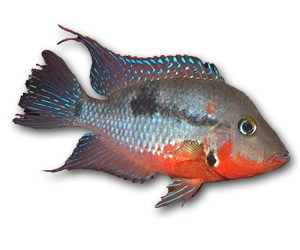Firemouth

Quick Stats
| Size | Up to 6.5" (17cm) |
|---|---|
| Tank | 120 litres + |
| Swimming Area | Bottom, Middle |
| Ph | 6.5 to 8.5 |
| Temperature | 75ºF to 82ºF (26 - 30°C) |
| Food | Flake, pellet, live and frozen |
Common Name:
Firemouth
Distribution:
Guatemala and the Yucatan peninsula of Mexico. It is also said to be found in underground waterways.
Colouration:
The most noticeable trait of the Firemouth is its throat and breast area, which ranges from bright fiery Red to Brick Red and is the reason for the common name. With a closer look you can see a wide range of colors in the fish. The basic background color is bluish Gray, with a slight purple sheen. The under area is Yellow Green to Orange. The sides have a series of faint dark bars. A Golden edged blackspot is right behind the eyes a similar one is found at the start of the tail fin. Other Black marks with Golden edges can be seen on the lower edge of the gill cover and at the start of the clear Pectoral fins. The Dorsal fin is edged in Red and the rays of the other fins are slightly Brown with the membranes speckled with Bright Blue - Green spots. All the scales seem to edged with Red. Females are not as colorful as the males. An all around beautiful fish!
Lifespan:
10 to 15 years.
Maintenance:
10 to 20% weekly water changes.
Feeding:
They are not fussy eaters and will accept flake and frozen food. Cichlid pellets are also accepted.
Substrate:
Sand only.
Tank Decor:
Ideally the Firemouth tank should be at least a 200 litre, with rocks, driftwood and many plants. Provide an open area for swimming and displaying.
Filtration:
Standard filter relevant to tank size.
Biotype:
Shallow shore areas of rivers with driftwood or rocks. The water can be clear murky or non moving.
Breeding:
Open water breeders, the pair will clean a rock or similar object and the female will deposit up to 500 eggs. Both parents will tend the fry as they are moved from pit to pit in the aquarium. The female is more likely to tend the brood and the male defend the territory. The fry can be fed very fine flake food or newly hatched brine shrimp. Growth is fairly fast. A healthy pair can have up to five broods a year.